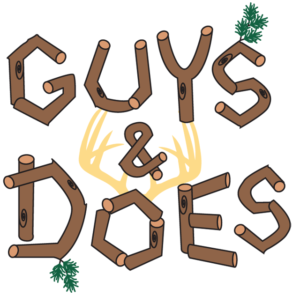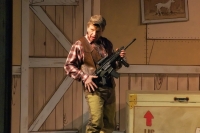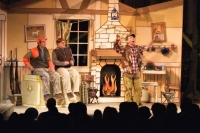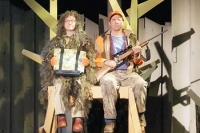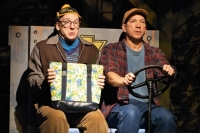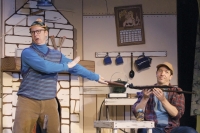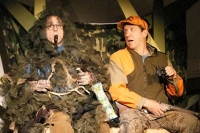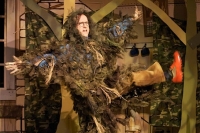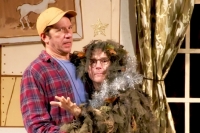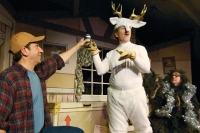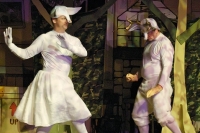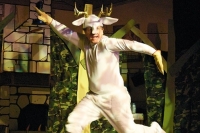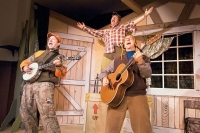
Book and Lyrics by Frederick Heide & Lee Becker
Music by Paul Libman
Fritz’s long-awaited break from his tedious job at the paper mill has arrived. Time to go deer hunting in the northwoods of Wisconsin, and ponder the mystery of what to get his wife for Christmas. Unfortunately, this year’s hunt finds him stuck bringing his daughter’s oddball boyfriend, Duane, who hopes to bond with Fritz and ask for his daughter’s hand. Fritz’s hunt is further complicated when a talking white buck suddenly appears at the cabin door, a mysterious and ancient creature seeking their help from the swaggering Texas hunter hot on his trail!
With its hilarious mix of whimsy and warmth, and a thoughtful look inside the world of hunting, this three-man musical comedy has sold out dozens of shows around the Upper Midwest (including 54 straight shows in its inaugural run). A favorite with hunters and non-hunters alike, Guys & Does is one show that truly delivers more bang for the buck!
Casting Notes
Size: 3 or 4
Breakdown: 3 or 4 male
Orchestration
Size: 3
Breakdown: 1 Keyboard / 1 Drum Set / 1 Bass
Photos
Plot
Guys & Does – Plot Summary
Wisconsin paper-mill worker Fritz Dingleheimer heads up north for a much-needed rejuvenating hunting trip. He reluctantly brings his daughter Susie’s boyfriend, dweeby non-hunter Duane Puddles, because Susie wants them to “bond.” Fritz and Duane travel from Nekoosa to the north woods (Up Nort’). In Fritz’s cabin, after losing his nerve in an attempt to ask Fritz for his daughter’s hand, Duane teaches Fritz to play his favorite card game (Slapjack). Fritz confides he has no idea what to get his wife for Christmas, unable to afford the trip to Helsinki, Finland that she wants. Duane confides that he’s scared of hunting as he recounts the childhood trauma of seeing Bambi (I Can’t Kill Bambi’s Brudder).
Texas big-game hunter Joe Jimmy Ray Bob Johnson III arrives, having tracked a mysterious rare animal into the area. He shares his over-the-top hunting philosophy (Another Notch in My Gun). He makes an offer to buy the Native American bow that hangs over the fireplace. Fritz explains it isn’t for sale, and Joe Jimmy leaves. The guys hit the sack and the head of a white buck appears, silhouetted in the window for a moment.
Fritz and Duane go hunting (Huntin’ Day). In the tree stand, Fritz warns Duane to avoid “Bobcat Hollow”, home to a mean mess of bobcats. Duane again fails to ask for Susie’s hand and annoys Fritz who sends him off to hunt on his own. Fritz ponders his wife’s Christmas present (What Do You Get Your Wife For Christmas?), takes aim at something, then lowers his gun, amazed. Duane, dressed in camouflage gear that makes him look like an evergreen, imagines life as a tree (If I Was A Tree).
Back in the cabin, Fritz tells Duane that he saw a white buck in the forest. Soon the buck, Staghart of the Golden Horns, arrives at the cabin. This Last King of the Elder Deer recounts his history to the dumbfounded hunters, including how Merlin taught him human speech (Staghart of the Golden Horns). Missing half his antlers, he cannot produce an heir with the last doe of his kind who lives in the nearby woods. He smells the approach of Joe Jimmy. Fritz and Duane hide Staghart in a big trunk.
Joe Jimmy comes in brandishing the broken antler he shot from Staghart’s head and prods Fritz once more to sell his bow, offering his $5000 watch in trade. Fritz declines, and Duane challenges Joe Jimmy to a game of Slapjack, putting the bow against the golden antlers for stakes. Duane wins and Joe Jimmy leaves the antlers, which are returned to Staghart who emerges from the trunk with a full rack, ready to find his doe and sire his heir (Staghart Reprise). In a two-act version, this is the show break.
Staghart searches the woods for his mate (Needing the Doe). Upon finding her, he and the white doe dance a whimsical ballet of courtship and lovemaking. Staghart returns to the cabin and encourages Fritz to rekindle the passion in his marriage (Guys and Does). He announces he will soon die and needs a noble hunter to kill him honorably so he can reach the afterlife (Avalon). Fritz reluctantly takes the bow from the wall and heads out to hunt Staghart.
In the woods, Duane sits in the tree stand and sings a sweet love song about Susie (Knitting Love Song). Joe Jimmy enters, intent on shooting Staghart (Hunting Day Reprise) and heads off toward “Bobcat Hollow” despite Duane’s warning. Fritz and Duane find Staghart, ready for his death (Staghart’s Solioquy). Fritz shoots him with his bow, and they momentarily mourn his loss. Staghart stands and thanks Fritz for sending him to Avalon and departs (Avalon Reprise).
Joe Jimmy returns to the cabin, clawed to shreds. He tells Fritz and Duane how his encounter with the bobcats has given him a new relationship to nature and a fresh perspective on hunting (Sacred Critter Choir). As he leaves, Fritz gives him the bow as a gift, refusing to trade for Joe Jimmy’s watch.
On the ride home, Duane finally gets Fritz’s blessing to marry his daughter and discovers Joe Jimmy slipped the gold watch into his knitting bag, allowing Fritz to take his wife to Helsinki after all (Finale – Up Nort’ Reprise).
Characters
CAST OF CHARACTERS
Fritz Dingleheimer – A Wisconsin, blue-collar, paper-mill worker, 40’s or older. A master hunter, ethical, kind, uncomfortable discussing feelings.
Duane Puddles – A low-level white-collar worker in the same paper mill, in love with FRITZ’s daughter. Nerdish, hyperactive, overly-talkative, he is famed locally as a hunting jinx.
Joe Jimmy Ray Bob Johnson III – A rich self-important Texas big-game hunter, with an underlying need to impress his father by killing the rarest possible game.
Staghart of the Goldenhorns – A pure-white buck with golden antlers, he is the last King of his kind. His speech is a mixture of more archaic language and the rural Wisconsin dialect of Fritz and Duane, as he tries to communicate with them. This role is designed to be played by the actor who plays Joe Jimmy, slipping a white jumpsuit and deer headpiece over his hunter costume.
White Doe – A female deer, mute. Appears in one dance number and can be played by the actor who plays Duane.
STAGING:
Northern Wisconsin.
The stage has a modest hunting cabin set upstage, with a roll-down front that shows the cabin from the outside. Moveable “trees” (or flats with trees on them) can be slid in front of that to take us deeper into the woods. The actors can shift the location in transitions.
There is also a tree stand to one side and a few feet off the stage for two guys to sit in. Essentially a chair in a tree, this could be moved in and out of place, or masked somehow when not needed.
Songs
LIST OF SONGS
1. Up Nort’ – Fritz and Duane joyfully drive from Nekoosa, WI to the north woods, finishing the number having arrived in Fritz’s family cabin.
2. Slapjack – Duane teaches Fritz his favorite card game.
3. I Can’t Kill Bambi’s Brudder – Duane recounts his boyhood trauma of seeing the film Bambi, as he explains why he’s afraid to hunt.
4. Another Notch in my Gun – Joe Jimmy Ray Bob shares his somewhat scary hunting philosophy.
5. Huntin’ Day – Early morning finds Fritz and Duane setting off for the day’s hunt. Duane gets a reminder in the rules of firearm safety. By song’s end they are in their tree stand.
6. What Do You Get Your Wife For Christmas? – Fritz puzzles over the question many a husband asks as the holidays approach.
7. If I Was a Tree – Duane’s leafy camouflage leads him down an unusual introspective path, as he imagines the arboreal life.
8. I, Christmas Tree – Duane sings a little unaccompanied snippet of the classic carol with modified lyrics.
9. Staghart on the Golden Horns – The majestic white deer shares his backstory, including his friendship with Merlin, who taught him human speech.
10. Staghart Reprise – His horn restored, Staghart is now primed to go find his mate. Fritz and Duane join in to send him off with a bang. This is the end of Act I, in the two-act version.
11. Needing the Doe – Staghart excitedly searches the woods for his mate.
12. Guys and Does – Fritz confides his marriage difficulties to Staghart, who offers his primal perspective on the matter.
13. Avalon – Staghart waxes poetic about the afterlife he hopes to achieve, with the help of a worthy hunter.
14. Knitting Love Song – Duane knits and pines for his love. In the pines.
15. Huntin’ Day Reprise – Joe Jimmy prepares to shoot Staghart.
16. Staghart’s Soliloquy – Staghart nobly faces his imminent demise.
17. Avalon Reprise – Staghart bids Fritz and Duane farewell, as he leaves for Avalon.
18. Sacred Critter Choir – A humbled and shaken Joe Jimmy returns from tangling with bobcats. A changed man he shares his revelation, as Fritz and Duane join in.
19. Up Nort’ Reprise – Driving back south, Fritz has a renewed energy for his marriage and Duane finally gets up the nerve to ask Fritz for his daughter’s hand. Fritz consents and it’s discovered that Joe Jimmy slipped his watch in Duane’s knitting bag as payment for Fritz’s bow. This means Fritz can give his wife Connie the trip she wanted and the show ends on a big happy note.
Set
SET
At the top of the show, Fritz and Duane sit downstage in a rolling seat with a steering wheel to represent the truck. In the original production, because of limited offstage space, this seat rotated 180 degrees to reveal a fireplace/mantle on the backside and was rolled into a space in the upstage wall of the cabin set as the opening number ended. This was then rolled back out for the final number as they drive home. Though not a requirement, this simple transformation was always satisfying for the audience.
The interior action takes place in front of a modest hunting cabin set upstage. In the cabin is corner with a small kitchen area for a beer cooler and hotplate. Upon arrival in the cabin, Fritz and Duane set up a small table for cards and meals. Small, foldable camp chairs can be used around the table. These furniture items, as well as Fritz’s cot, can be stored in the large trunk against the upstage wall. This trunk needs a false back and must be big enough for an actor to disappear into to accommodate Staghart’s disappearance and quick-change into Joe Jimmy.
Moveable “trees” (or small flats with trees on them) are slid in front of the cabin set to take us deeper into the woods for hunting scenes that are played downstage of the cabin set. The actors can shift these in transitions, if necessary. The cabin could also be masked by a forest-painted drop, or by other means, depending on a theatre’s technical capacity.
There is a tall tree stand to one side, with room for two. In the original production the seat was a simple, but very sturdy platform about 8 feet off the deck, a ladder on either side so both could ascend/descend simultaneously. Above and behind the seat were stylistic representations of branches, strong enough to hang various hunting items from, as needed.
PROPS:
- 2 Duffle Bags (1 Fritz, 1 Duane)
- Hunting rifle with scope in soft case (Fritz)
- Small Cooler (Full of “beer”. Cans of seltzer water in beer cozies work fine. Also contains a lidded tupperware bowl of “stew”.)
- Duane’s Knitting Bag (with knitting project inside – needles, yarn, partially completed project)
- Book – Feeling Freely for Fellas (in Duane’s knitting bag)
- Small thermos of “chamomile tea” (also in Duane’s knitting bag)
- Decks of cards on mantle (ideally preset so slapjack games end with proper number of cards being played.)
- Small cook pot on hotplate for cooking stew (original production used no actual food)
- Bowls and spoons for eating stew
- Coffee pot (old fashioned camp perk) and cup
- Native American bow on wall above mantle
- Helsinki Cruise Brochure (Fritz)
- Military-style assault rifle (Joe Jimmy)
- Broken golden antler
- Binoculars (Fritz – hunting)
- Second hunting rifle (no scope, for Duane when hunting)
- Star with headband and garland (in trunk, for Duane to add to his tree suit to become a “Christmas tree”)
- Completed knitting project for reveal in final song.
Author Notes
Author Notes
Guys & Does offers a mix of both the down-to-earth and the fantastical, as it explores the complex theme of hunting from a variety of angles.
In Fritz we have a master hunter who simply enjoys getting away to bond with nature and is beyond the need to bag trophies. Duane is the reluctant novice who has a more troubled relationship to the killing of wildlife. In Joe Jimmy, we have another accomplished hunter, but one whose rapacious approach to nature conflicts with Fritz’s reverence for his prey. And we have Staghart of the Golden Horns, a regal, otherworldly character who is able to speak for nature and shed a unique light on the questions that arise around the theme of hunting.
A key to producing G&D is balancing the comic elements and the more serious moments that begin to arise as Staghart appears and shapes the action. While an actor dressed as a talking deer is undoubtedly a comical idea, it’s crucial that Staghart’s demeanor and portrayal be given appropriate weight, especially for his final moments in the show to have sufficient payoff.
In the same way, Joe Jimmy, while a spoof of a Texas hunter, must also be a believable menace, with a bit of a dark, unpredictable side.
Even Duane, who is the most comic of the characters, needs to be played with a sincere earnestness for an audience to care about his journey.
Given the broader comedic moments in the show, it could be easy to overlook the deeper, more thoughtful layers at work in the story. Approaching these characters not as cartoons, but as real people with real concerns is required to give the show its intended heart.
A look at the script will show that Fritz and Duane’s lines have been written in a version of the Wisconsin rural dialect. A primary element of that is the replacing of most “TH” sounds with a “D”. There are occasional instances where the substitution doesn’t happen, and this usually has to do with ease of speech. Another component of the dialect is a slightly darker long “O” sound, which can be accomplished by putting the sound more in the nose, while making a slight “oo” shape with the lips (e.g., doncha know). The key to making this dialect work is allowing it to be natural and easy-going, without sounding like extra work.
Press
Media Reviews
Four out of Four Stars! With a ballet by deer, knitting jokes and a talking buck, Guys & Does dares to be far-out different and succeeds. The musical comedy is about deer hunting and more. It is stoked with thoughts on types of hunters, the philosophy of hunting, male-female relationships, being in love and earthiness in the natural world. The music by Paul Libman fits whatever setup, be it an operatic lament (“I Can’t Kill Bambi’s Brudder”), sweet (“Knitting Love Song”) or fun-loving (“Ain’t Dat a Kick in Da Pants?”). Cosmic and mind-bending!
– Warren Gerds, Green Bay Press-Gazette
The often smart and funny musical is wowing audiences. Guys and Does has plenty of charm and many nice musical moments. The exuberant, tuneful “Huntin’ Day” is followed by a couple of sweet ballads. Sportsmen will adore it. All in all, Guys and Does is a nice theatrical package that is sure to please hunters and theatergoers alike.
– Anne Siegel, TotalTheatre.com
Going well beyond musical comedy with emotional depth, Guys & Does also addresses aboriginal and ecological issues that articulate deeper concerns without weighing-down what is essentially a light, casual Wisconcentric musical comedy. The great white buck with golden antlers (named Staghart of the Golden Horns) is probably the single cleverest bit in the entire musical. The character has a strange otherworldly quality about him—vaguely familiar yet also majestic in kind of a bizarrely comic way. The central plot has more than enough depth to keep Guys & Does interesting through the final scene.
– Russ Bickerstaff, Shepherd Express
A unique treat. The lyrics are clever: You have to appreciate rhyming “pester us” with “estrus.” The tunes are appropriately jaunty. Flourishes like accompaniment by a deer call are fun. The audience at the premiere chortled and chuckled plenty. I did too.
– Josh Wimmer, Isthmus
Ready for a singing, dancing, wisecracking albino buck? “Guys & Does” is one of AFT’s most constantly funny and entertaining shows. The situations have the audience in stitches. Very imaginative…Riotous!
– Marty Lash, Door County Advocate
Pricing
Guys & Does – General Pricing Info
Amateur Production:
Producing organization shall pay to Northern Sky a flat fee for the Run equal to the cost of a full price adult ticket multiplied by the number of performances of the Run multiplied by the number of seats in the Theater multiplied by .08.
Professional Production:
Northern Sky shall be paid a royalty of Ten Percent (10%) of gross weekly box office receipts (“GWBOR”) from the production of the Musical during the Run.
Transfer agreements will be issued upon receipt of licensing application and any applicable deposit or flat fee payment.
High resolution vector format show logo packets are also available for an additional $30 usage fee.
Order Perusal License this Show

